
|
|
|
|
|
. William Garner Sutherland, D.O., developer of Cranial Osteopathy, 1939 |
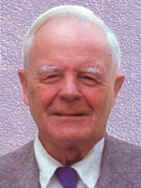 |
|
.
If you get a deep cut in your finger, the attending doctor will disinfect, close, and bandage the wound. In a week the cut is mended. Did the doctor heal you? Actually, no. Your own body did. But the physician assisted - by setting the stage and removing obstacles that might interfere with your body's repair processes. In much the same way but with a larger scope, a physician who practices traditional Osteopathy (or Osteopathic Manipulative Medicine) removes the impediments to normal body functions and corrects the physical abnormalities that cause disease and inhibit recovery. Like unkinking a garden hose, this allows your own innate healing abilities to come forth and restore you naturally to optimal health. Osteopathy,
first developed by Andrew Taylor Still,
M.D. at the end of the 1800s, is both a type of medical
practice and a philosophy - interchangeable and inseparable.
Practitioners have their knowledge solidly rooted in the details
of anatomy, their guidance found in the unerring wisdom of
the body; their partner in healing the elemental energies of
life. D.O.s have learned how the body’s systems work together, and why a small physical disturbance in one area may greatly impact functions elsewhere. They are concerned with determining what is causing an imbalance in the body and why. Osteopaths have found that once the underlying causes have been diagnosed, treated and removed, the body is then free to repair itself or to respond to other appropriate therapies more successfully. How Osteopathy Works 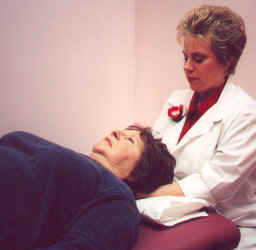 Osteopathy
has been defined as "a comprehensive system of diagnosis and treatment,
based on the interrelationship of anatomy and physiology, for the study,
prevention and treatment of disease." The entire body, if
adequately nourished, functions to maintain, repair and heal itself
to the best advantage if its structure and physiological functioning
are in proper order.
Osteopathy
emphasize the following four fundamental principles: Osteopathy
has been defined as "a comprehensive system of diagnosis and treatment,
based on the interrelationship of anatomy and physiology, for the study,
prevention and treatment of disease." The entire body, if
adequately nourished, functions to maintain, repair and heal itself
to the best advantage if its structure and physiological functioning
are in proper order.
Osteopathy
emphasize the following four fundamental principles:
When putting these principles into action, they first find imbalances in the anatomy, often old and hidden, by touch. They then apply gentle manipulation to the bones, muscles, organs, and all connective tissue over the entire body to restore normal structure and remove restrictions. This enhances all circulatory systems, allowing the body’s own healing powers to better reach ailing areas. D.O.s also consider how all aspects of a patient’s life, including diet, exercise, physical and emotional stresses, genetic, and environmental and occupational issues, influence their overall state of health. By combining natural therapies with a physician’s knowledge of western medicine, Traditional Osteopaths work to correct the true underlying cause of dysfunction. They can relieve pain, prevent disease, and speed recovery from nearly all medical problems. Often they can reduce or even eliminate the need for more intrusive therapies such as medication or surgery. Cranial Osteopathy
Some of Dr. Sutherland's techniques have been isolated and simplified to create what's called "Craniosacral therapy." Be aware the majority of practitioners trained in this are massage therapists, chiropractors, and physical and occupational therapists who usually have little to no understanding of the underlying structure, biology or rational for the techniques.
|
|
|
Extra - A Short History of Osteopathy
The full benefits of Osteopathy were widely revealed during the Great Flu Epidemic of 1918. 500,000 deaths were seen in the United States from this disease, and those who were admitted to hospitals had an alarming fatality rate. However, patients treated by Osteopaths had only one sixteenth as high a fatality rate. Their mobilized immune system effectively fought the infection, while congestion in the lungs and other waste products from virus die-off were thoroughly drained.
Today, Osteopaths comprise about 5% of all physicians in the U.S., but with their comprehensive training and personable orientation make up 15% of all rural doctors. Unfortunately only 1 out of every 10 Osteopaths nationwide actually use their traditional manipulative techniques as a primary modality. The remaining large majority, perhaps owing to the relative convenience, have put aside their holistic training and practice mostly conventional medicine identical to their allopathic MD counterparts. This ratio may be changing, as it has been reported that more medical students "see the writing on the wall" and are shifting their emphasis towards the ever-more-popular holistic approach of Traditional Osteopathy. Dr. Still's and Sutherland's work has also generated over the past century several "spin-off" therapies, including chiropractic and "craniosacral," which by their nature tend to be limited to a fraction of an Osteopathic physician’s training and full range of healing techniques. |
|
|
|
|
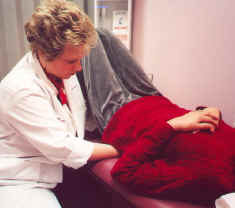 Doctors
of Osteopathy (D.O.s) are fully licensed physicians with credentials
equal to M.D.s, who practice all phases of medicine, including writing
prescriptions and performing surgery. However, they are trained
to look at the whole person; mind, body, and spirit, rather than focus
on diseased parts. They understand that the human body has a
nearly unlimited power to heal and maintain itself, but sometimes
needs assistance in removing obstacles that block it from achieving
its full health potential.
Doctors
of Osteopathy (D.O.s) are fully licensed physicians with credentials
equal to M.D.s, who practice all phases of medicine, including writing
prescriptions and performing surgery. However, they are trained
to look at the whole person; mind, body, and spirit, rather than focus
on diseased parts. They understand that the human body has a
nearly unlimited power to heal and maintain itself, but sometimes
needs assistance in removing obstacles that block it from achieving
its full health potential.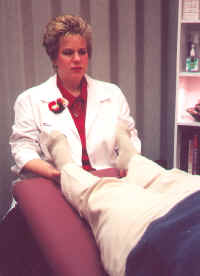 Doctors
of Osteopathy understand that health will manifest to its fullest potential
only when all parts of the body are in correct relationship to one another
and free to move within their normal range of motion. They know
that resistance to disease depends on normal blood and nerve supply.
Such integrated totality emphasizes the fundamental need for the physician
to consider the individual who has the diseases rather than the
disease which has the individual - the principal approach being
through proper normalization of the total body structure.
Doctors
of Osteopathy understand that health will manifest to its fullest potential
only when all parts of the body are in correct relationship to one another
and free to move within their normal range of motion. They know
that resistance to disease depends on normal blood and nerve supply.
Such integrated totality emphasizes the fundamental need for the physician
to consider the individual who has the diseases rather than the
disease which has the individual - the principal approach being
through proper normalization of the total body structure.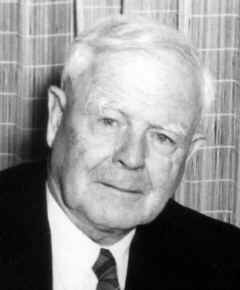 Cranial
Osteopathy is a prominent sub-specialty of Traditional Osteopathic medicine,
and was discovered, developed and taught by
William Garner Sutherland, DO. He determined that there
is a palpable movement within the body that occurs in conjunction with
the motion of the bones of the head. This is a rhythmic alternating
expansion and contraction motion in the cranium, independent of the
rhythms of heart beat or breathing, which is part of the Primary
Respiratory Mechanism (PRM). This motion exists in every
cell of the body and can be felt and worked with in any part of the
body by a trained physician. The aim is to free up restrictions
in the PRM and allow the subtle natural rhythms of the central nervous
system to express themselves in a balanced fashion.
Cranial
Osteopathy is a prominent sub-specialty of Traditional Osteopathic medicine,
and was discovered, developed and taught by
William Garner Sutherland, DO. He determined that there
is a palpable movement within the body that occurs in conjunction with
the motion of the bones of the head. This is a rhythmic alternating
expansion and contraction motion in the cranium, independent of the
rhythms of heart beat or breathing, which is part of the Primary
Respiratory Mechanism (PRM). This motion exists in every
cell of the body and can be felt and worked with in any part of the
body by a trained physician. The aim is to free up restrictions
in the PRM and allow the subtle natural rhythms of the central nervous
system to express themselves in a balanced fashion.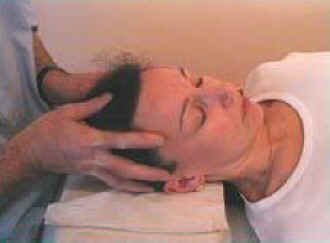 Cranial
Osteopathy is uniquely suited to treat problems related to the skull
and brain, yet it can potentially affect any situation arising from
disease or trauma in the body. Even an almost imperceptible alteration
of the skull's natural configuration and movement in infants can lead
to such disorders as colic, the inability of the baby to swallow, or
frequent spitting up or delayed development. Trauma affecting
this mechanism can lead in adults to low back problems, headaches, breathing
and digestive disorders, joint pains, menstrual disorders and repetitive
stress injuries such as tendinitis.
Cranial
Osteopathy is uniquely suited to treat problems related to the skull
and brain, yet it can potentially affect any situation arising from
disease or trauma in the body. Even an almost imperceptible alteration
of the skull's natural configuration and movement in infants can lead
to such disorders as colic, the inability of the baby to swallow, or
frequent spitting up or delayed development. Trauma affecting
this mechanism can lead in adults to low back problems, headaches, breathing
and digestive disorders, joint pains, menstrual disorders and repetitive
stress injuries such as tendinitis. 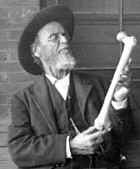 Traditional
Osteopathy is an entirely American form of holistic medical care that
was developed in the late 19th century by Andrew
Taylor Still, MD. Dr. Still, a frontiersman and civil
war physician, was dissatisfied with the crude and often toxic medicine
of his day. By observing wildlife and the elegant relationship
between structure and function, he originated a new system of medicine,
which he called "Osteopathy." He noted that when adequately
nourished and rested, the body can heal and maintain itself if all
its parts are in their correct position and free to move within the
normal range of motion. Dr. Still developed the first manipulating
techniques in modern medicine, used to restore structure and function,
and started treating his patients with this new concept in 1874.
Owing to his ever-growing success and the demand that generated, he
founded in his home town of Kirksville, Missouri the first Osteopathic
college in 1892. 19 such colleges are now teaching Osteopathy
nationwide.
Traditional
Osteopathy is an entirely American form of holistic medical care that
was developed in the late 19th century by Andrew
Taylor Still, MD. Dr. Still, a frontiersman and civil
war physician, was dissatisfied with the crude and often toxic medicine
of his day. By observing wildlife and the elegant relationship
between structure and function, he originated a new system of medicine,
which he called "Osteopathy." He noted that when adequately
nourished and rested, the body can heal and maintain itself if all
its parts are in their correct position and free to move within the
normal range of motion. Dr. Still developed the first manipulating
techniques in modern medicine, used to restore structure and function,
and started treating his patients with this new concept in 1874.
Owing to his ever-growing success and the demand that generated, he
founded in his home town of Kirksville, Missouri the first Osteopathic
college in 1892. 19 such colleges are now teaching Osteopathy
nationwide.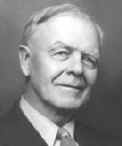 One
of Dr. Still's students, Dr. William Garner
Sutherland, greatly expanded the science of Osteopathy
by developing in the late 1930's the field of "Cranial Osteopathy."
He found that the primary rhythm of the body, from which all other
energy flowed, was revealed in the pulsing of cerebral and spinal
fluids. This rhythmic pulse, not related to heartbeat, respiration,
or any previously known cycles of the body, creates a coiling and
uncoiling of the spinal cord that can be felt by a trained practitioner
anywhere on the patient. Special osteopathic manipulation of
the cranial bones and sacrum can then gently free up restrictions
and balance this primary rhythm movement. The functioning of
the central nervous system is improved, which then impacts the health
of the entire body. His concepts and therapies were so unique,
even to Osteopathy, that he worked for decades before they were finally
accepted by his colleagues.
One
of Dr. Still's students, Dr. William Garner
Sutherland, greatly expanded the science of Osteopathy
by developing in the late 1930's the field of "Cranial Osteopathy."
He found that the primary rhythm of the body, from which all other
energy flowed, was revealed in the pulsing of cerebral and spinal
fluids. This rhythmic pulse, not related to heartbeat, respiration,
or any previously known cycles of the body, creates a coiling and
uncoiling of the spinal cord that can be felt by a trained practitioner
anywhere on the patient. Special osteopathic manipulation of
the cranial bones and sacrum can then gently free up restrictions
and balance this primary rhythm movement. The functioning of
the central nervous system is improved, which then impacts the health
of the entire body. His concepts and therapies were so unique,
even to Osteopathy, that he worked for decades before they were finally
accepted by his colleagues. 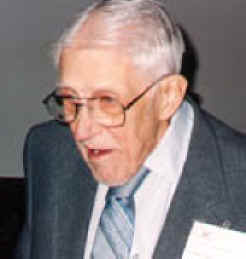 As
Osteopaths struggled after WWII to gain equal recognition as MDs,
their practices shifted as well in that direction towards conventional
allopathic medicine. The manipulative techniques that made them
special were all but lost. One of the few Osteopaths who steadfastly
maintained the techniques and philosophy of traditional manipulation
during this time was Dr. Robert Fulford,
who helped bring back Dr. Still's and Sutherland's teachings to the
newest generation of physicians. His own work included the development
of the
As
Osteopaths struggled after WWII to gain equal recognition as MDs,
their practices shifted as well in that direction towards conventional
allopathic medicine. The manipulative techniques that made them
special were all but lost. One of the few Osteopaths who steadfastly
maintained the techniques and philosophy of traditional manipulation
during this time was Dr. Robert Fulford,
who helped bring back Dr. Still's and Sutherland's teachings to the
newest generation of physicians. His own work included the development
of the